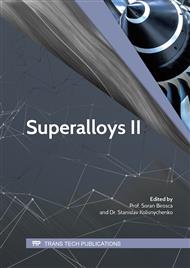[1]
G.H. Gessinger. Powder Metallurgy of Superalloys. London : Cambridge university press, (1984).
Google Scholar
[2]
R.C. Reed. The superalloys fundamentals and application. London: Cambridge university press, (2006).
Google Scholar
[3]
E. Nembach, K. Suzuki et al. In-situ deformation of the gamma prime hardened superalloy Nimonic PE16 in high-voltage electron microscopes. Philosophical Magazine, 51A (1985) 607–618.
DOI: 10.1080/01418618508237581
Google Scholar
[4]
M. Condat, B. Decamps et al. Shearing of γ' precipitates by single a/2 <110>matrix dislocations in a γ/γ' Ni-based superalloy. Scripta metallurgical. 21 (1987) 607-612.
DOI: 10.1016/0036-9748(87)90369-3
Google Scholar
[5]
B. Decamps, A.J. Morton et al. On the mechanism of shear of γ' precipitates by single (a/2)<110> dissociated matrix dislocations in Ni-based superalloys. Philosophical magazine. 64 (1991) 641-668.
DOI: 10.1080/01418619108204866
Google Scholar
[6]
B. Decamps, J. Panisson. High resolution imaging of shearing configurations of γ' precipitates in ni-based superalloys. Scripta Metallurgica et Materialia. 30 (1994) 1425-1430.
DOI: 10.1016/0956-716x(94)90240-2
Google Scholar
[7]
B. Decamps, S. Raujol et al. On the shearing mechanism of γ' precipitates by a single (a/6)<112> Shockley partial in Ni-based superalloys, Phil. Mag. A 84 (2004) 91–104.
DOI: 10.1080/14786430310001621472
Google Scholar
[8]
D. Locq, P. Caron et al. On the role of tertiary γ'precipitates in the creep behaviour at 700°c of a pm disk superalloy. Superalloys 2004, Edited by K.A. Green et al, TMS, (2004).
DOI: 10.7449/2004/superalloys_2004_179_187
Google Scholar
[9]
M. Kolbe. The high temperature decrease of the critical resolved shear stress in nickel-base superalloys. Materials Science and Engineering A319–321 (2001) 383–387.
DOI: 10.1016/s0921-5093(01)00944-3
Google Scholar
[10]
G.B. Viswanathan, P.M. Sarosi et al. Investigation of creep deformation mechanisms at intermediate temperatures in Rene88DT. Acta Materialia 53 (2005) 3041–3057.
DOI: 10.1016/j.actamat.2005.03.017
Google Scholar
[11]
R.R. Unocic G.B. Viswanathan et al. Mechanisms of creep deformation in polycrystallineNi-base disk superalloys. Materials Science and Engineering A483–484 (2008) 25–32.
DOI: 10.1016/j.msea.2006.08.148
Google Scholar
[12]
G.B. Viswanathan. Deformation mechanisms at intermediate creep temperatures in the Ni-base superalloy Rene88 DT. Materials Science and Engineering A 400–401 (2005) 489–495.
DOI: 10.1016/j.msea.2005.02.068
Google Scholar
[13]
P.M. Sarosi, G.B. Viswanathan and M.J. Mills. Direct observation of an extended complex stacking fault in the γ' phase of a Ni-base superalloy. Scripta Materialia 55 (2006) 727–730.
DOI: 10.1016/j.scriptamat.2006.06.019
Google Scholar
[14]
L. Kovarik, R.R. Unocic et al. Microtwinning and other shearing mechanisms atintermediate temperatures in Ni-based superalloys. Progress in Materials Science 54 (2009) 839–873.
DOI: 10.1016/j.pmatsci.2009.03.010
Google Scholar
[15]
R.R. Unocic, L. Kovarik et al. Deformation mechanisms in Ni-base disk superalloys at higher temperatures. Superalloys 2008, R C. Reed et al., TMS, (2008).
DOI: 10.7449/2008/superalloys_2008_377_385
Google Scholar
[16]
R.R. Unocic. Dislocation decorrelation and relationship to deformation microtwins during creep of a γ' precipitate strengthened Ni-based superalloy. Acta Materialia 59 (2011) 7325–7339.
DOI: 10.1016/j.actamat.2011.07.069
Google Scholar
[17]
F.P.E. Dunne et al. Length scale-dependent, physically-based hcp crystal plasticity: Applicationto cold-dwell fatigue in Ti alloys. International Journal of Plasticity 23 (2007) 1061–1083.
DOI: 10.1016/j.ijplas.2006.10.013
Google Scholar



